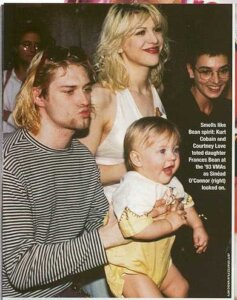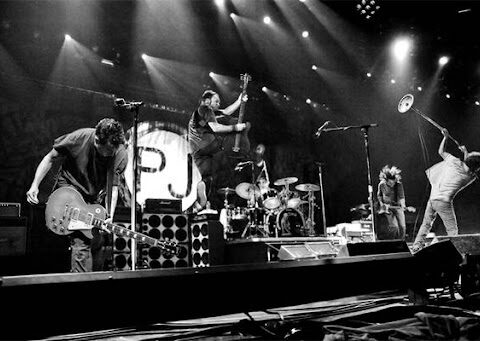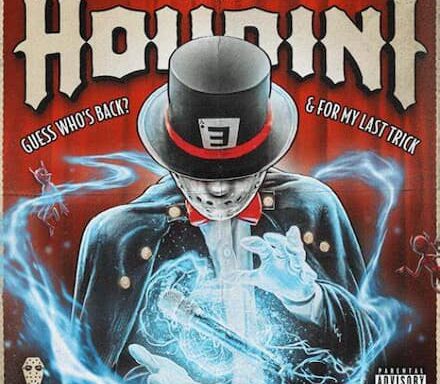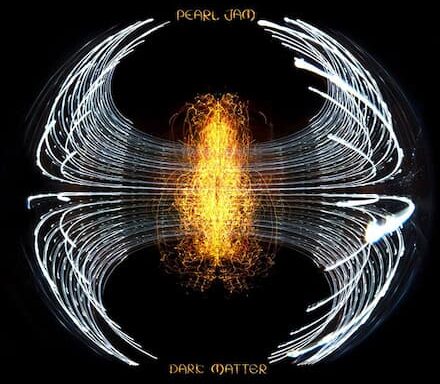The term ‘icon’ gets thrown around a little too casually in the media: but Sinead O’Connor is or was absolutely the real thing, if anyone ever has been.
The Sinead O’Connor of the late 80s and early 90s in particular had a level of iconic that was entirely unique.
It wasn’t just about her voice or her captivating image (although even calling it an ‘image’ is tricky, as it was largely uncultivated): for someone in their late teens and early twenties to be thrust into the limelight like that and yet come off as so sharply intelligent and so meaningfully engaged is extremely rare.
Back in the day, I wore out the VHS tape of Value of Ignorance: and especially kept rewinding it to watch her live performance of ‘Jerusalem’ from The Lion and the Cobra. Honestly, I was kind of in love with her in my early teens.
But it wasn’t until I got older that I started to understand how significant she was, beyond music or image.
Most pop stars, especially today, but even back then, had little or nothing of any depth to say about anything: either through fear of rocking the boat or through genuine lack of interest or engagement.
Watch, for example, this interview she gave to Arsenio Hall in 1991… and see if you could find a modern pop star who could (or, more importantly, who would) talk like that on prime time chat show. Bear in mind she is only 23 in this footage.
But she seems more concerned with talking about social issues or about America’s actions in the Middle East than about promoting her music.
Watch the Arsenio interview in its entirety and you’ll notice how uncomfortable or uncertain the audience is and how infrequently they clap or react. The sterile and staged world of American prime time television was not ready for anything as authentic or as bullshit-free as Sinead O’Connor.
The same dynamic runs through most things she ever did. To say that she was determined to be socially and politically outspoken is an understatement. But more accurately it was about being honest, undiluted, and rejecting the nonsense of showbiz.
Even when it was at the expense of her career or popularity. Not only was she always rocking the boat: the courage of it is that it repeatedly came at the expense of her livelihood and her image. Some say she sabotaged her own career: but you always got the sense she cared more about whatever the point was she was making than about whatever backlash there might be.
As she herself said, “I could stand in the street and sing and get enough to pay the bills. I don’t need millions of dollars.”
When she refused to have the American anthem played at one of her shows, for example, it resulted in media outrage and a boycott of her music by multiple radio stations. But, as her statements at the time showed, she didn’t really care. Disgusted by the wave of blind patriotism that was present in America at that time (driven by Bush Snr’s Gulf War and the media’s frothing celebration of the military industrial complex and its assault on Iraq), she was of course entirely justified in not wanting the national anthem associated with her concert.

Which is of course entirely what you’d want from a peace activist and self-described protest singer. When she wanted to stage a peace concert in Israel, she was widely boycotted by Israeli patriots. The man who led the campaign against her is now a major figure in the Israeli government. What a great age we live in.
Which naturally brings us to the infamous moment in 1992 when she appeared on SNL in the US and, after reciting Bob Marley, tore up a picture of the Pope, referring to him and the church as “the real enemy”.
O’Connor was banned from American network television. Other celebrities attacked her for it. Madonna mocked her actions. Joe Pesci went on SNL and proclaimed that he would’ve hit her if he’d been in the room. A bulldozer was deployed in New York to destroy a pile of Sinead O’Connor records. Death threats also followed.
What Sinead had been doing, of course, was protesting against the Catholic Church’s cover up of child sex abuse by a number of its priests.
The fact that Madonna, Pesci and most of the media condemned or belittled her just demonstrates the extent to which establishment media and mainstream celebrities were protecting the church’s public image for the longest time.
Bear in mind that it wasn’t until years later that open discussion of child abuse in the church started to occur. But in 1992, she was trying to be a voice for the voiceless. The fact is that, while the establishment media (and establishment celebrities) were protecting the church, it took a fragile twenty-five year old singer to have the guts to use her platform to actually say something.

Sinead, herself a victim of abuse (and also a product of the infamous Magdalene asylums for ‘fallen women’ in Ireland, where numerous young women suffered at the hands of nuns for decades), was way ahead of anyone else in this respect: and she made her stand alone. Contemporaries did not rally around her.
And the price was to be demonised and mocked instead of having her guts applauded.
The price was also to her commercial success in the US. General perception is that O’Connor, who was essentially almost a superstar at this point, sabotaged her own material interests with this: never quite recovering in terms of sales or public image.
Shortly after the SNL incident, she appeared at a Bob Dylan tribute concert with a host of other musicians but was booed by most of the crowd. She stood her ground, however, and soldiered on with her unaccompanied performance. That appearance perfectly encapsulates the change in trajectory of her ‘career’ post-SNL as compared to pre-SNL.
As many of Sinead’s fans and supporters have said over the years, she has been owed a big apology for a long time – especially from the American media.
Especially after the extent of the scandal in the Catholic Church has since come to broader attention: to the point where it is now common knowledge. But such an apology never really came.
Instead, most media coverage of O’Connor (or Shuhada Sadaqat, after her adoption of the Sufi form of Islam in the last few years) in subsequent years focused on her mental health issues more than anything else. And it could be argued that various people and commentators used the idea of her as an ‘eccentric’ and unstable personality as a way to limit her cultural or moral impact, or to smother anything she had to say.

For the record, she later admitted to having been not only physically and mentally brutalised by her mother as a child, but to having been raped on several occasions by different people. Which, with hindsight, makes the way her SNL protest was treated seem even more disgusting.
The British tabloid press also owes her an apology for the way it treated her: but if the British gutter press was to start apologising to people it has bullied, it would have to print nothing but apologies for the next ten years.
The ‘problem’ with Sinead O’Connor, who was clearly an empath and someone who cared deeply about both human beings and injustice, is that she never had any interest in playing the pop, celebrity or media game.
She identified more as punk than as a pop star: and in fact referred to herself as an activist right from the beginning.
A lot of people in the system, including other celebrities or stars, feel threatened by that: for one thing, because it shows them up.
Madonna, the High Priestess of female pop stars at the time of Sinead’s commercial breakthrough, must’ve felt uncomfortable about this young punk from Ireland suddenly becoming a big deal, not to mention having the No.1 single in the world in 1990: all without having to resort to overt sexuality, getting her tits out or performing in her underwear.
This might be why, according to O’Connor herself, Madonna made fun of her shaved head and her general appearance, saying she wasn’t sexy enough to be a star.
In terms of the phoney ‘feminist icon’ accolade that Madonna revelled in, it’s all the more perverse when you consider that she was saying this stuff at a time when Sinead’s record company was trying to pressure the then-twenty-year-old into having an abortion because pregnancy would undermine her image and hurt sales.

But simple jealousy might also explain why Madonna seemed to relish the backlash against Sinead’s SNL appearance in 92, staging a parody of it shortly after. The irony of course was that Madonna – a self proclaimed feminist icon – would attack a younger female artist for her appearance or for not being ‘sexy’ enough, while simultaneously making fun of her when she dared to speak out about something as serious as child abuse.
Of course it was more hypocrisy than irony: and with a touch of insecurity – the kind of insecurity that occurs when a phony feels threatened by the real deal. Also, when you consider the lengths someone like Madonna had to go to manufacture her image in every performance or every music video, you can imagine how annoying it might’ve been to then see this kid from Ireland have the biggest hit of the year: and with an almost instantaneously iconic video that consisted of nothing more than her face against a black background singing to camera.
And yet what Madonna video would be considered as iconic or impactful as the bare-boned video for ‘Nothing Compares 2 U’? That video was everywhere in 1990. In fact it’s hard to think of a music video as iconic or pervasive as that one was.
Even Prince, who wrote that song, seemed unhappy about how impactful Sinead’s version of it was. Let’s be honest: if you go and listen to Prince’s version, it’s nothing special. When O’Connor took that song, she made it so singularly and powerfully her own that no one, not even its original writer, could really touch it again.
As it happened, there was also bad blood between Sinead and Prince, including an allegation that he assaulted her at one point. We won’t go into that stuff here: but maybe it’s something to touch on some other time, as there’s some interesting stuff Sinead said about Prince and Arsenio Hall. The interview referenced earlier on Arsenio Hall’s show actually becomes a little creepy if Sinead’s later claims about him are true. But again, let’s leave that for now.
Arsenio in fact sued her. And Prince was never positive about her version of his song: in fact, Prince’s estate blocked the makers of the Nothing Compares documentary from being able to use any of Sinead’s biggest hit in the film.
Which is just as well: as undeniably powerful as that song and video are, it was better to have a bit more attention on some of O’Connor’s other songs, such as her breakthrough single ‘Mandinka’ (inspired by the TV show Roots) and the brilliantly potent early track ‘Jackie’.
Also, ‘Jerusalem’ is one of the best pop singles of the 80s and doesn’t get enough attention in general.
But all of this does highlight how much Sinead O’Connor didn’t really fit in with the major celebrity crowd or industry system, especially in the US.
An Irish punk or protest artist who only knew how to be sincere and authentic was always going to have problems navigating all the phoniness and bullshit. It was always interesting that O’Connor, who had boycotted the Grammy’s previously, attended the MTV music awards in 1993, but seemingly spent the entire time hanging out with Kurt and Courtney and playing with one-year-old Frances. Cobain was probably more suitable company for her than the likes of Prince or Madonna.

At any rate, Morrissey is right when he calls out the hypocrisy of all the other ‘stars’ eulogising her after her sad death at the age of 56, when hardly anyone supported her when she was alive, particularly during her well documented mental health struggles in more recent years and the personal tragedies that had befallen her.
But that lack of support or solidarity was nothing new: it spanned the whole of her career. She spent most of that commercial career standing alone as a singular entity defying categorisation. Which might be why a lot of people had a hard time figuring out how to pigeonhole her. You can’t keep someone in their place if you can’t work out what their ‘place’ is.
The fact that her funeral, held yesterday, had her being buried in Muslim tradition but in a Catholic cemetery just further demonstrates how she couldn’t be pigeonholed, even in death. And the fact that thousands turned out to see her off demonstrates her impact.
Again, ‘icon’ gets thrown around way too much in pop culture. As far as real ‘icons’ go, they’re few and far between. Sinead O’Connor, particularly the Sinead O’Connor of the late 80s and early 90s, will be an icon forever.
And fuck Joe Pesci. And Madonna. And all the bullshit and hypocrisy.
Sinead maybe summarised her own life (and maybe even her afterlife) aptly when she said: “Whatever it may bring, I will live by my own policies, I will sleep with a clear conscience, I will sleep in peace.”
_________________
_________________





Wow. Thank you for this piece. I was born in 1990 and knew very little about her. I will definitely check out more of her work b/c of your article.
Thanks Beebopaloolie. Check ‘Jackie’ and ‘Jerusalem’ in particular.